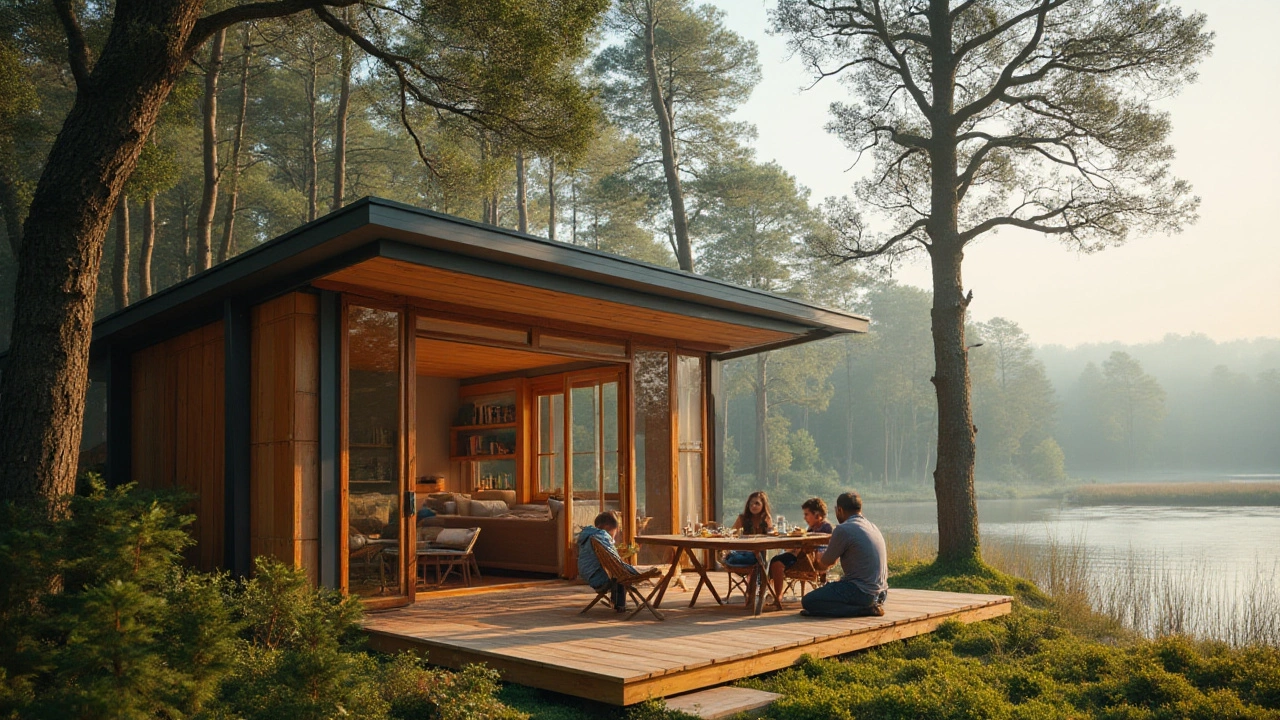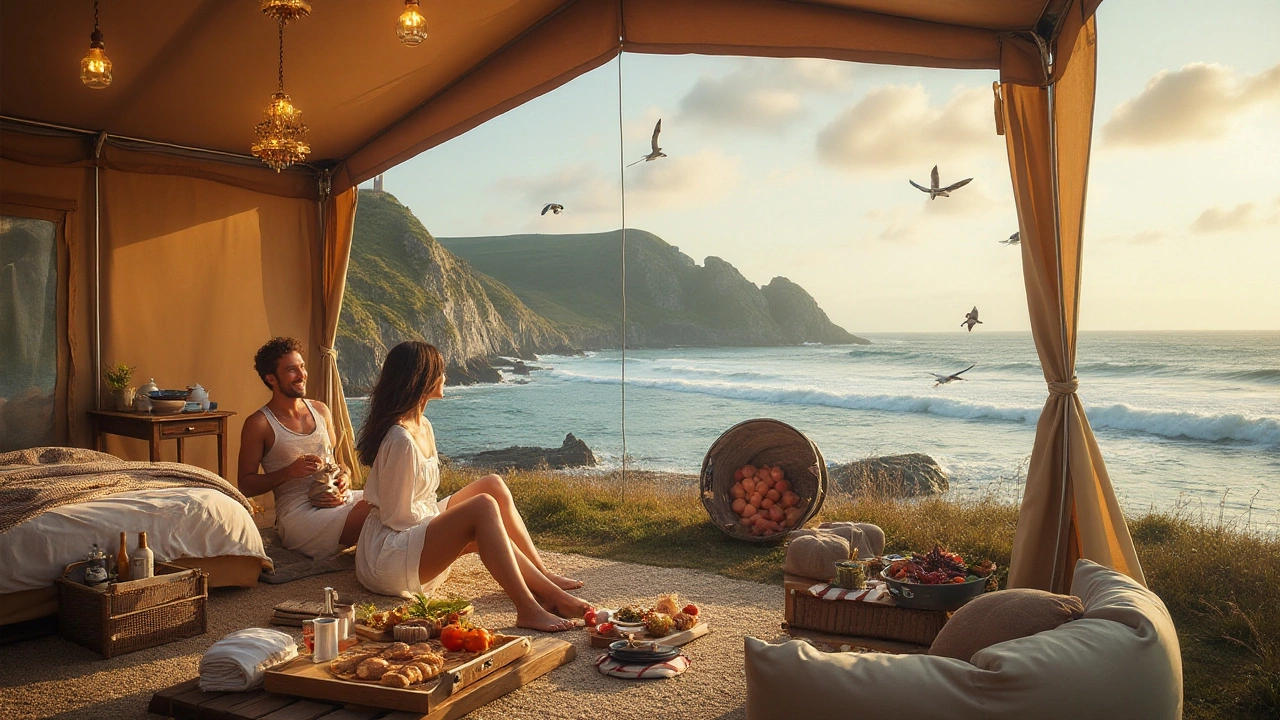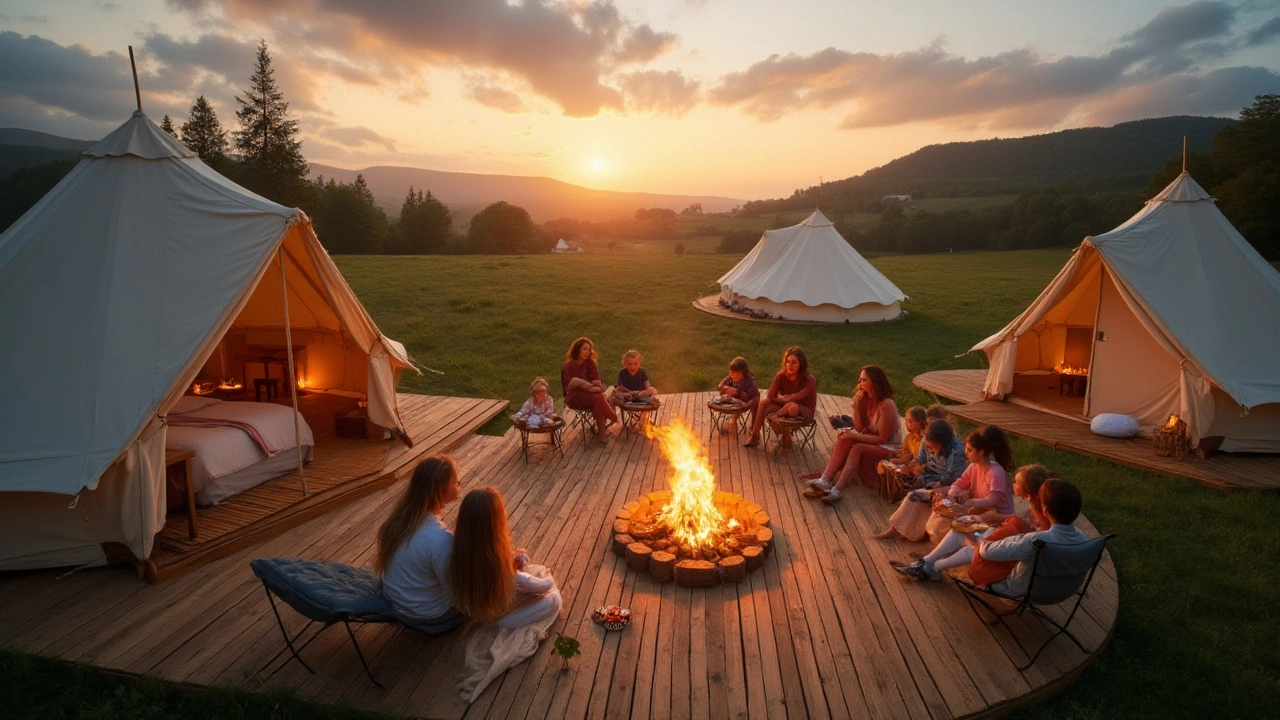In recent years, the idea of combining comfort with the rugged beauty of nature has transformed camping into an experience known as glamping. But where did this concept originate, and why has it captured the hearts of so many? The allure of glamping goes beyond simple luxury, merging the best of outdoor adventure with modern conveniences.
While traditional camping has its rustic charm, glamping invites you to experience the wilderness without forfeiting any creature comforts. Think along the lines of king-size beds under a starlit sky or exquisite meals prepared in the heart of nature. This article unpacks the nuances of why we call it glamping and how it's redefining the way we engage with nature.
- The Birth of Glamping
- Growing Popularity
- What Sets Glamping Apart
- Cultural and Historical Influences
- Ecological and Environmental Impact
- Choosing the Perfect Glamping Site
The Birth of Glamping
The concept of glamping is not as modern as one might think. Its roots can be traced back to the early 1900s when affluent travelers sought to blend luxury with the emerging thrill of outdoor exploration. In 1920s Africa, wealthy visitors on safari refused to forfeit the comforts of home. These discerning adventurers commissioned elaborate mobile tent installations featuring amenities reminiscent of lavish hotels, complete with fine china and Persian rugs. Indeed, it's these early safari-goers who set the stage for what we now recognize as luxury camping.
The essence of glamping began coalescing as society evolved and people's relationship with leisure activities started to shift. During the Renaissance, royals and noblemen engaged in opulent hunts that included grandiose accommodations. Fast forward to the 21st century, a resurgence of this luxurious form of camping emerged amid the backdrop of technological advancements and a growing desire to reconnect with nature. This renaissance aligned with a cultural pivot towards experiences that offered both the comfort of modernity and the primal satisfaction of immersing oneself in the natural world.
While the term 'glamping' was officially coined around 2005 in the United Kingdom, it's impossible to overlook the impact global societal changes had by making glamping accessible to a broader audience. The 2008 economic downturn, for instance, pushed people to seek more affordable yet fulfilling vacations. Nature's allure combined with economic prudence made glamping an attractive option. What mattered then, as now, was the promise of a unique escape—a seamless fusion of luxury and simplicity.
"People don't need more things; they need more experiences," said Richard McGuire of the renowned travel consultancy Traveluxe.
Growing Popularity
The rise of glamping can be attributed to a cultural shift towards experiences that blend luxury and nature in innovative ways. People crave authentic encounters with the natural world but often wish to forgo the discomfort traditionally associated with camping. As urbanization increases, so does our hunger for retreats into the wild, where we can unwind without sacrificing the comforts we're used to. This demand has led to a boom in luxury camping sites all over the globe, offering options from opulent tents in the Serengeti to treehouses nestled deep within ancient forests.
The trend has been further fueled by social media, as picturesque glamping sites provide the perfect backdrop for Instagram-worthy photos. The 'digital detox' movement plays into this as well, with unplugged retreats promising a way to recharge away from relentless notifications. It’s no surprise then that glamping appeals to a broad demographic, from millennials seeking unique travel experiences to retirees looking for peaceful, amenity-rich escapes.
Impact of Technology and Economy
Technological advances have also played a significant role in the popularity of glamping. Innovations in portable solar panels, battery storage, and eco-friendly technologies allow glamping sites to remain off-grid and sustainable without compromising on essential utilities like hot water, heating, and electricity. Economically, glamping sits at the sweet spot between budget-friendly camping and expensive luxury hotels, making it a more accessible option for many.
"Glamping is thriving because it allows people to connect with nature without the stress of planning a traditional camping trip," says travel expert Jane Wilson. "It merges the peace we find in natural settings with the indulgence of modern living."
According to data from the glamping industry, there’s been a noticeable uptick in bookings over the past five years, particularly in countries like the United States, the United Kingdom, and Australia. A survey conducted in 2023 found that 60% of respondents preferred glamping over traditional camping, citing comfort and ease as primary reasons.
| Year | Global Glamping Market Growth (%) |
|---|---|
| 2020 | 18% |
| 2021 | 22% |
| 2022 | 25% |
| 2023 | 30% |
The growing appetite for eco-tourism also plays a part, as many glamping sites are designed with sustainability in mind. Whether it’s using reclaimed materials, conserving water, or promoting conservation efforts, these initiatives resonate with travelers keen to minimize their environmental footprint.

What Sets Glamping Apart
Glamping stands out in the realm of outdoor recreation by merging the ruggedness of nature with the comforts of luxury. This juxtaposition entices those who seek adventure yet crave the plushness of hotel-like amenities. Unlike traditional camping, where sleeping bags and basic tents are the norm, glamping places you in accommodations that range from well-appointed tents to treehouses with modern facilities. These setups often include furniture, private bathrooms, and sometimes even amenities like air conditioning and hot tubs—a far cry from the usual camping checklist filled with gear and survival essentials.
One of the particularly compelling aspects of glamping is its inclusivity—it allows adventurers of varying tastes and capabilities to step into nature without sacrificing comfort. For many, this means there's no need to forgo a high thread count or gourmet meals while soaking in the sights and sounds of the wild. A cozy bed, sometimes set on a platform overlooking a breathtaking vista, provides not just a place to rest but a stage from which to savor the beauty of the great outdoors. This is not merely a tent stay; it's an opportunity to live in harmony with nature without braving its harsher elements.
An article in The New York Times highlighted glamping's appeal, stating, "Glamping offers the tent-afraid a chance to fall asleep to the sounds of nature with little direct contact with critters and creepy crawlies." This highlights the assurance and security glamping offers its participants.Technological innovations have further propelled glamping into the mainstream. Wi-Fi-equipped cabins allow digital nomads to continue their work in inspiring environments, while eco-friendly solar-powered setups cater to those with a consciousness for carbon footprint. The integration of technology in glamping sites exemplifies a modern take on camping, facilitating a lifestyle that aligns with contemporary demands.
Equipped with modern necessities, these sites often incorporate local aesthetics and offer immersive experiences that are unique to their geography. This can mean anything from a safari tent in the savannahs of Africa to a yurt high in the Mongolian steppes. With glamping history rooted in the opulence of safaris where wealthy travelers insisted on comfort while delving into the wilderness, today’s glamping is grounded in accessibility while maintaining a sense of indulgence. Let's not overlook the positive ripple effects on local economies due to the infrastructure required to support such glamping sites, which many destinations worldwide have begun to capitalize on.
Cultural and Historical Influences
Glamping, a blend of 'glamorous' and 'camping,' is not just a modern buzzword but a concept deeply rooted in history and culture. This trend might seem like a recent invention, but it's essentially a reimagining of luxurious outdoor accommodations dating back centuries. The early semblance of luxury camping can be traced to the royal and noble families of centuries past who traveled with opulent tents and an array of home creature comforts. Famous historical campaigns such as the Field of the Cloth of Gold in 1520 saw vast setups of makeshift castles and intricate campgrounds crafted to reflect wealth and status.
During the Ottoman Empire, for example, Sultan's entourage would travel with lavishly decorated tents, complete with silk carpets and plush furnishings. These portable palaces could provide the comforts of their regal homes while being set up in the most scenic spots the empire had to offer. Their penchant for luxury on the move drew from an intrinsic desire to blend conveniences with the grandeur of the great outdoors, a desire glamping admirably fulfills today. Thomas Cook also played a historical role in transforming outdoor leisure when he organized civilized camping trips in Victorian England, allowing the adventurers of the era to experience nature with plush facilities.
Even in more recent history, explorers and travelers of the 20th century often found themselves in need of practical yet opulent lodgings, blending the adventure of travel with essential mod-cons. African safaris, made famous in the early 1900s, provided lavish lodge-style tents, enabling participants to experience wilderness exploration without compromising on luxury and style. The demand for such experiences has, over time, evolved and found its place in the glamping trend we see today. In today's world, these influences resonate across cultures, allowing travelers from varying backgrounds to indulge in the wonders of nature coupled with sumptuous comforts.
According to John Marmaduke, a travel historian, "Glamping is in many ways a testament to human ingenuity and desire for balance, perfectly merging the thrill of the natural world with the comfort of modernity."
The cultural impacts of glamping reflect our evolving relationship with nature, where the boundaries of comfort are continually pushed. It caters to the modern sensibility of wanting to retreat into the zen of nature without the forfeiture of conveniences, a cultural shift evident in our increasing emphasis on both sustainability and wellbeing. It's this historical continuum that has championed the cause of glamping as not just a mode of travel but a cultural phenomenon. The ability to choose from yurts, treehouses, or repurposed vintage trailers symbolizes a broader demand within society for experiences that are unique, meaningful, and story-worthy.

Ecological and Environmental Impact
When it comes to luxury camping, the environmental footprint is an essential consideration. Unlike traditional camping, which often requires campers to bring minimal gear and leave minimal trace, glamping often involves more substantial amenities that necessitate careful planning and sustainable practices. From plush bedding to electrical power setups, the demands of glamping can potentially strain natural resources if not managed thoughtfully. As the popularity of luxury outdoor accommodations grows, so does the responsibility to protect our fragile ecosystems. Glamping businesses are increasingly aware of this and often take proactive steps to minimize their impact, such as utilizing solar panels for energy and sourcing materials locally to reduce transportation emissions.
One of the significant ecological advantages of glamping is its potential to encourage sustainable tourism that supports conservation efforts. Some glamping sites are situated within eco-resorts or on protected lands, where revenue from guests contributes directly to conservation initiatives. In this way, glamping can foster a deeper appreciation and understanding of the natural environment among its patrons. However, it's crucial that these sites adhere to rigorous sustainability standards, ensuring that the luxury provided to guests doesn't come at the expense of the environment. Proper waste management systems, use of renewable resources, and efforts to educate guests about the local ecology can significantly mitigate any negative effects associated with glamping.
The question of whether glamping is more or less environmentally friendly than traditional camping depends significantly on the practices of the operators and the behavior of the guests. In 2022, a study conducted by the Environmental Impact Assessment Review highlighted that sites employing sustainable practices saw not only a reduction in negative impact but also an increase in guest satisfaction. Facilities that integrate permaculture techniques into their landscapes, for example, not only contribute to ecological preservation but often provide educational opportunities for visitors to connect with nature in meaningful ways.
"Glamping opens a gateway to reconnect with nature, enhance appreciation for our environments, and serve as a catalyst for sustainable change," said Dr. Laura Miller, leading ecologist at Green Future Institute.
When selecting a glamping destination, travelers can take steps to ensure their stay is as eco-friendly as possible. Researching each site's sustainability practices can reveal how well they align with personal values surrounding environmental stewardship. Look for certifications from recognized environmental organizations that offer insights into how committed a location is to maintaining its ecological integrity. Additionally, opting for sites that provide information on local wildlife and conservation efforts can ensure that guests' experiences go beyond relaxation, adding an educational element that enhances the value of their stay. By choosing a destination with a focus on environmental responsibility, adventurers can enjoy the best of both worlds: unrivaled comfort in nature without the guilt of a heavy ecological footprint.
Finally, the scalability of glamping supports diverse eco-spaces – from mountainous terrains to coastal areas - each with its unique environmental needs. Many glamping operators recognize this and strive to create environmentally harmonious developments. The challenge lies in expanding this model globally, ensuring all glamping sites encapsulate the principles of sustainable luxury camping while respecting the delicate balance of nature.
Choosing the Perfect Glamping Site
Embarking on a glamping trip is all about finding that sweet spot where adventure meets luxury. With a myriad of options available, selecting the perfect site can be both exciting and overwhelming. One vital aspect to consider is the location. Depending on your preferred landscape—be it a forest, mountain range, or beachside—you should aim for a site that not only caters to your aesthetic preferences but also offers activities that pique your interest.
Consider what kind of amenities are important to you. Some might value having a private bathroom and full kitchen setup, while others might prioritize access to communal spaces where guests can converge. Understanding what you want from your luxury camping experience helps narrow down your choices. Dive deeper into the amenities list; some sites boast unique features like hot tubs, pools, or even personal chefs for an elevated experience.
Seasonality can greatly affect your glamping adventure, so be prepared. Summer might seem like the ideal time to go glamping, but fall or spring can offer a quieter, more serene atmosphere. Researching the climate and seasonal attractions of potential sites ensures you're met with the best that nature has to offer during your stay. "The secret of getting ahead is getting started," as Mark Twain wisely noted, which is true when planning your luxury camping escapade.
Now, think about the kind of accommodation that appeals to you. Do you fancy a spacious safari tent, a cozy yurt, or perhaps an innovative treehouse? Each offers a distinct experience, so take time to explore what aligns with your travel aspirations. Consider group size too; larger parties may require more sprawling accommodations, while couples or solo adventurers might opt for intimate, secluded spots.
If sustainability and ecological impact matter to you, it's essential to look into the environmental policies of the glamping site. Many sites now prioritize being earth-friendly, using solar panels or composting toilets to minimize their footprint. Asking questions about these initiatives can be telling and ensure your getaway doesn't come at the earth's expense.
Lastly, value your desired balance between seclusion and community. Some travelers enjoy the privacy of remote cabins, while others appreciate the social aspect of community spaces and activities. Checking reviews from previous guests can offer insight into the site's vibes and help gauge whether it matches your personal preferences. By thoroughly considering these factors, you are well on your way to crafting an unforgettable and rewarding glamping experience that seamlessly blends the thrill of the wild with the comforts of home.
